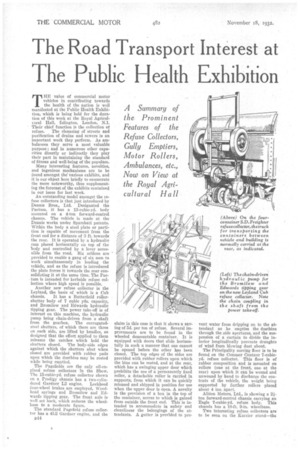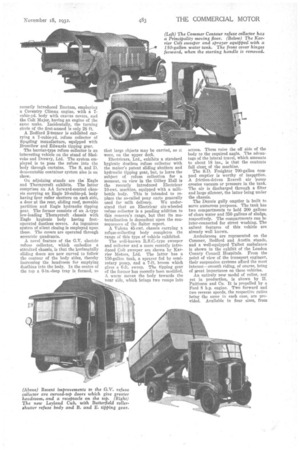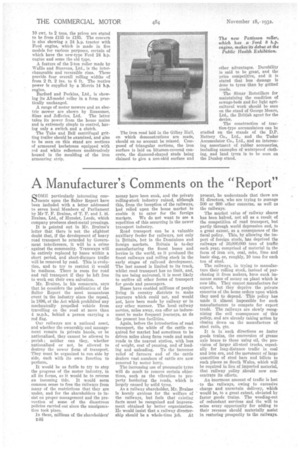The Road Transport Interest at
Page 70

Page 71

Page 72

If you've noticed an error in this article please click here to report it so we can fix it.
The Public Health Exhibition
A Summary of the Prominent Features of the Refuse Collectors, Gully Em pliers, Motor Rollers, Ambulances, etc., Now on View at the Royal Agricultural Hall
THE value of commercial motor vehicles in contributing towards the health of the nation is well manifested at the Public Health Exhibition, which is being held for the duration of this week at the Royal Agricultural Hall, Islington, London, N.1. Their chief function is the collection of
refuse. The cleansing of streets and purification of drains and sewers is an important work they perform. As ambulances they serve a most valuable purpose ; and in numerous other capacities directly or indirectly they play their part in maintaining the standard of fitness and well-being of the populace.
Many interesting features, novelties, and ingenious mechanisms are to be found amongst the' various exhibits, and it is our object here briefly to enumerate the more noteworthy, thus supplementing the forecast of the exhibits contained in our issue for last week.
An outstanding model amongst the refuse collectors is that just introduced by Dennis Bros., Ltd. Designated the Pactum, it has a 13-cubic-yd. body mounted on a 4-ton forward-control chassis. The vehicle is made at the Dennis works under Sparshatt patents. Within the body a steel plate or partition is capable of movement from the front end for a distance of 3 ft. towards the rear. It is operated by a hydraulic ram placed horizontally on top of the 'body and controlled by a lever accessible from the road. Six orifices are provided to enable a gang of six men to work simultaneously in loading the vehicle, and as the refuse is introduced the plate forces it towards the rear consolidating it at the same time. The Pactum is intended for kerbside refuse collection where high speed is possible.
Another new refuse collector is the Leyland, the basis of which is a Cub
chassis. It has a Butterfield rollershutter body of 7 cubic yds. capacity, and Bromilow and Edwards hydraulic tipping gear. The power take-off is of interest on this machine, the hydraulic pump being chain-driven from a shaft from the gearbox. The corrugatedsteel shutters, of which there are three on each side, are lifted by handles, so designed that the effort applied to them releases the catches which hold the shutters closed. The body-side edges against which the shutters abut when closed are provided with rubber pads upon which the dustbins may be rested while being emptied.
The Pagefields are the only oil-engined refuse collectors in the Show. The 15-cubic-yd. refuse collector shown on a Prodigy chassis has a two-cyliudoted Gardner L2 engine. Lockheed four-wheel brakes are employed, Woodhead springs and Bromilow and Edwards tipping gear. The front axle is well set hack, which reduces the wheelbase to a moderate figure.
The standard Pagefield refuse collector has a 4L2 Gardner engine, and the E44
claim in this case is that it shows a saving of 5d. per ton of refuse. Several improvements are to be found in the wheeled demountable container. It is equipped with doors that slide horizontally in such a manner that one cannot be opened before the other has been closed. The top edges of the sides are provided with rubber rollers upon which the bins can be rested, and at the rear, which has a swinging upper door which prohibits the use of a permanently fixed roller, a detachable roller is carried in supports, from which it can be quickly released and shipped in position for use when the upper door is open. A novelty is the provision of a box in the top of the container, access to which is gained from outside the front end. This is intended to accommodate in safety and cleanliness the belongings of the attendants. A gutter is provided to pre vent water from dripping on to the attendant as he empties the dustbins through the side apertures, and the suspension of a curtain to divide the interior longitudinally prevents draughts of wind from blowing dust about.
The Principality moving floor is to be found on the Commer Centaur 7-cubicyd. refuse collector. This floor is of rubber composition and is mounted on rollers (one at the front, one at the rear) upon which it can be wound and unwound by hand to discharge the contents of the vehicle, the weight being supported by further rollers placed about 4 ins. apart.
Albion Motors, Ltd., is showing a 21ton forward-control chassis carrying an Eagle 7-cubic-yd. refuse body. This chassis has a 10-ft. 9-in. wheelbase.
Two interesting refuse collectors are to be seen on the Karrier stand—the recently introduced Bantam, employing a Coventry Climax engine, with a 7cubic-yd. body with canvas covers, and the Colt Major, having an engine of the same make. incidentally, the turning circle of the first-named is only 28 ft. A Bedford 2-tonner is exhibited carrying a 7-cubic-yd. refuse collector of Spnriing manufacture, equipped with Bromilow and Edwards tipping gear. The barrier-type refuse collector is an interesting vehicle on the stand of Shelvoke and Drewry, Ltd. The system employed is to pass the refuse into the body through curtains. The S. and D. demountable container system also is on show.
On adjoining stands are the Eagle and Thornycroft exhibits. The latter comprises an AA forward-control chassis carrying an Eagle 10-cubic-yd. body having four roller shutters on each side, a door at the rear, sliding roof, movable partition and Eagle hydraulic tipping gear. The former consists of an A-type low-loading Thornycroft chassis with Eagle hygienic body having footoperated dustless covers. An ingenious system of silent closing is employed upon these. The covers are operated through eccentric quadrants.
A novel feature of the G.V. electric refuse collector, which embodies a standard chassis, is that the horizontally sliding doors are now curved to follow the contour of the body sides, thereby increasing the headroom for emptying dustbins into the body. In the centre of the top a 6-in.-deep tray is formed, so that large objects may be carried, as it were, on the upper deck.
Electricars, Ltd., exhibits a standard hygienic dustless refuse collector with the maker's patent sliding shutters and hydraulic tipping gear, but, to leave the subject of refuse collection for a moment, on view in the Gilbey Hall is the recently introduced EIectricar 10-cwt. machine, equipped with a milkbottle body. This is intended to replace the so-called pony carts generally
used for milk delivery. We understand that an Electricar six-wheeled refuse collector is a pending addition to this concern's range, but that its materialization is dependent upon the consequences of the Salter report.
A Vulcan 45-ewt. chassis carrying a refuse-collecting body completes the range of this type of vehicle exhibited.
The well-known R.S.C.-type sweeper and collector and a more recently introduced Colt sweeper are shown by Karrier Motors, Ltd. The latter has a 150-gallon tank, a sprayer fed by semirotary pump, and a 7-ft. broom which gives a 6-ft. sweep. The tipping gear of the former has recently been modified. A worm moves the body towards the near side, which brings two ramps into
action. These raise the off side of the body to the required angle. The advantage of the lateral travel, which amounts to about 18 ins., is that the contents fall clear, of the machine. The S.D. Freighter 700-gallon cesspool emptier is worthy of insNction. A friction-driven Reeve11 air 'pump creates vacuum or pressure in the tank. The air is discharged through a filter and large silencer, the latter being under the chassis.
The Dennis gully emptier is built to serve numerous purposes. The tank has two compartments to hold 200 gallons of clean water and 250 gallons of sludge, respectively. The compartments can be inter-connected for street washing. The salient features of this vehicle are already well known.
Ambulances are represented on the Commer, Bedford and Austin. stands, and a well-equipped Talbot ambulance is shown in the exhibit of the London County Council Hospitals. From the point of view of the transport engineer, their suspension systems afford the most interest—smooth riding, of course, being of great importance on these vehicles.
An entirely new model of roller, not yet in production, is shown by H. Pattisson and Co. It is propelled by a Ford 8 h.p. engine. Two forward and two reverse speeds, the respective ratios being the same in each case, are provided. Available in four sizes, from
10 cwt. to 2 tons, the prices are stated to be from M5 to £195. The concern is also showing a 24 h.p. tractor with Ford engine, which is made in five models for various purposes, certain of which have the new-type Ford 24 h.p. engine and some the old type.
A feature of the 2-ton roller made by Wallis and Steevens, Ltd., is the interchangeable and reversible rims. These provide four overall rolling widths of from 2 ft. 2 ins. to 6 ft. The motive power is supplied by a Morris 14 h.p. engine.
Barford and Perkins, Ltd., is showing its AR-model roller in a form practically unchanged.
A range of motor mowers and an electric mower are shown by Ransomes, Sims and Sefferies. Ltd.. The latter takes its power from the house mains and is extremely simple to control, having only a switch and a clutch.
The Tuke and Bell centrifugal gritting trailer should be examined, and also to be seen on this stand are sections of armoured kerbstones equipped with red and white reflectors unobtrusively housed in the moulding of the iron armouring strip. The iron road laid in the Gilbey Hall, on which demonstrations are made, should on no account be missed. Composed of triangular sections, the iron surface is laid on bitumen coveredconcrete, the diamond-shaped studs being claimed to give a non-skid surface and other advantages. Durability is said to be great, and the price competitive, and it is stated that less damage is done to tyres than by gritted roads.
The Simar Rototillers for maintaining the condition of sewage-beds and for light agricultural work should be seen on the stand of George Mourn, Ltd., the British agent for the device.
The construction of traction-type accumulators can be studied on the stands of the D.P. Battery Co., Ltd., and the Tudor Accumulator Co., Ltd., and an interesting assortment of rubber accessories, including examples of waterproof clothing, and land tyres is to be seen on the Dunlop stand.




















































































































